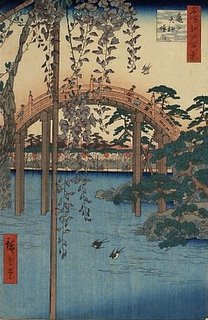
Kamedo Tenjin Shrine: drum bridge in the garden, Hiroshige ukiyo-e
During the Asuka period (538-710), gardens were supposed to express Buddhism and Taoism through replicating the mountainous regions in China.
During the Heian period (794-1185), gardens shifted from solely representing religious beliefs to becoming, “a place for ceremonies, amusement, and contemplation” (Miller).

peter in a japanese garden
In the Kamakura and Muromachi periods (1185-1573), a great many gardens were created during these two time periods due to improved garden techniques and the development of Syoinzukuri style. Zen beliefs were also flourishing at this time and had great influences over garden techniques and purposes. Another factor that allowed gardens to flourish stems from the fact that the shoguns simply enjoyed gardens.
After the Muromachi Period, Japanese tea ceremonies became an intricate part of Japanese culture. Sen no Rikyu (1517-1591) created the traditional style of a tea house where there was usually a roji (“dewy path”) leading to the house. Besides the tea houses, gardens constructed in the Edo period (1603-1868) reflected the tastes and style of each individual shogun ruler. Instead of being a religious symbol, gardens shifted to being a symbol of a shogun’s prestige and power (Miller).
adapted from wikipedia.org

Zen Clocks by Now & Zen
Now & Zen
1638 Pearl Street
Boulder, CO 80302
Posted in Japanese Inspired Zen Clocks, Now & Zen Alarm Clocks, Progressive Awakening, Zen Gardens, Zen Timers